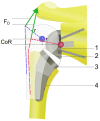The Evolution of Reverse Total Shoulder Arthroplasty-From the First Steps to Novel Implant Designs and Surgical Techniques
- PMID: 35329837
- PMCID: PMC8949196
- DOI: 10.3390/jcm11061512
The Evolution of Reverse Total Shoulder Arthroplasty-From the First Steps to Novel Implant Designs and Surgical Techniques
Abstract
Purpose of review: The purpose of this review is to summarize recent literature regarding the latest design modifications and biomechanical evolutions of reverse total shoulder arthroplasty and their impact on postoperative outcomes.
Recent findings: Over the past decade, worldwide implantation rates of reverse total shoulder arthroplasty have drastically increased for various shoulder pathologies. While Paul Grammont's design principles first published in 1985 for reverse total shoulder arthroplasty remained unchanged, several adjustments were made to address postoperative clinical and biomechanical challenges such as implant glenoid loosening, scapular notching, or limited range of motion in order to maximize functional outcomes and increase the longevity of reverse total shoulder arthroplasty. However, the adequate and stable fixation of prosthetic components can be challenging, especially in massive osteoarthritis with concomitant bone loss. To overcome such issues, surgical navigation and patient-specific instruments may be a viable tool to improve accurate prosthetic component positioning. Nevertheless, larger clinical series on the accuracy and possible complications of this novel technique are still missing.
Keywords: biomechanics; computer navigation; implant design; patient-specific instruments; reverse total shoulder arthroplasty.
Conflict of interest statement
The authors declare no conflict of interest.
Figures



References
Publication types
LinkOut - more resources
Full Text Sources
Research Materials
Miscellaneous

